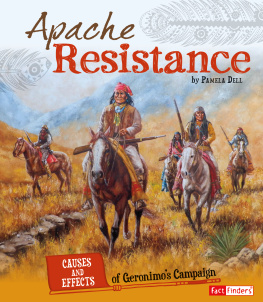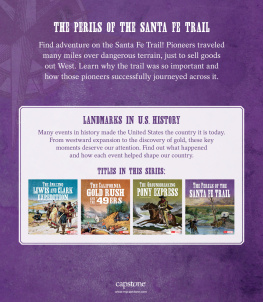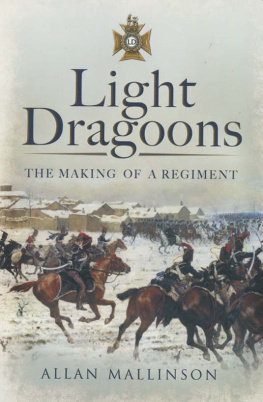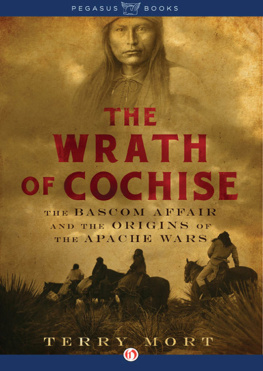ABOUT THE AUTHOR
In 2018, Doug Hockings biographyTom Jeffords: Friend of Cochise (think Jimmy Stewart in Broken Arrow riding alone into Cochises Stronghold to make the peace) was honored with a Spur Award from Western Writers of America and a Co-Founders Award from Westerners International. Award-winning author and speaker Doug Hocking is an independent scholar who has completed advanced studies in American history, ethnology, and historical archaeology. He is a retired armored cavalry officer who also worked in military intelligence. He grew up among the Jicarilla Apache and paisanos of the Rio Arriba (Northern New Mexico). True West Magazine named Black Legend: George Bascom, Cochise, and the Start of the Apache Wars Best Indian History of 2018. His work has appeared in True West, Wild West, Desert Tracks, and the Journal of Arizona History. Doug is a gubernatorial appointee to the board of the Arizona Historical Society.
ACKNOWLEDGMENTS
No author writes a book alone, so there are many people to thank.
My wife, Debbie, as always read my days work and let me know if it was intelligible. At the Donnelly Library at New Mexico Highlands University, in Las Vegas, New Mexico, I got some wonderful help from the librarians Irisha Corral, Loretta Duran, and April Kent, who were in possession of a wonderfully helpful set of records from Fort Union. Youll find many, many quotes from those records herein. The works of Tiller, Bender, Murphy, and others kept me on track so looking into those records of the past, I knew what the authors were talking about. Its a wonderful experience to read the secondary history and then to suddenly see events through the eyes of someone who was there. Debra Chatham, at Sierra Vista Library, as always was a wonderful help getting me books and articles, often letting me have a bit more than library rules allowed.
I need to thank friends among the Jicarilla who have helped with the present work including Veronica Velarde Tiller, Sheldon Nuez-Velarde, who makes pots in the old way, Vida Vigil-Garcia, tribal historian along with Vernon Petago, and Vidas sister, Claudia Vigil-Muniz. Some of these folks have been friends since childhood and Vernon remembered that Id dated his cousin. Price Heiner, Carson National Forest archaeologist, was helpful with information about the Cieneguilla battlefield, and Greg Michno provided helpful information and assistance. Bernd Brand went with me to Cieneguilla. We walked a very long way despite an injury to his leg. The folks at the New Mexico State Library, Joy Poole and Amy Schaefer, were absolutely wonderful and let me in to go through records at a time when the library was closed for remodeling. Heather McClure, and Hannah Abelbeck, photo imaging specialist, at the Palace of the Governors Photo Archive were wonderfully helpful devoting a lot of time to finding me pictures and in suggesting others that might be helpful. Bunker de France and Harry Alexander on Voices of the West have always been supportive and helped to get the message out. Clay Renick at the Hutchison County Museum, in Borger, Texas, maintains a wonderful museum and was helpful in getting us to the Adobe Walls Battlefield. Lastly, Gene and Rosanna Baker have always been helpful and supportive of my work.
Our friend, Ron Woggon, loves endnotes, so I made sure that there were plenty just for him. I have to thank Chris Enss for introducing me to the wise and instructive Erin Turner, who despite Rons thoughts encouraged me to reduce the number of endnotes. And last I should thank my helpful friends of the Amigos and Ladies of the West, many of them TwoDot authors, who share a booth with me at the Tucson Festival of Books: Lowell Volk, Carol Markstrom, Bill Markley, Chris Enss, Melody Groves, Vonn McKee, Rod Timanus, and Kellen Cutsforth.
APPENDIX A: POSTS AND FORTS OF THE JICARILLA COUNTRY
Fort, camp, post, cantonment. In military parlance, the operation of a fort was paid for from the budget of the Department of the Army, while the operation of a camp was paid for from the regimental budget, e.g., 1st Regiment of Dragoons, 2nd Regiment of Dragoons, 7th Infantry, 3rd Artillery. A post is a place where soldiers are assigned duty, and thus, is at least in theory temporary and may include facilities leased from civilians. A cantonment is the portion of a post where buildings are located, such as barracks. In civilian and infantry parlance, a fort is a place to fight from and defend. For cavalry, including dragoons, forts tend to be open without exterior walls with large parade grounds, a place to live and graze livestock, not a fortification. For civilians, a fort may also refer to a private trading post such as Bents Fort and Barclays Fort.
Abiquiu (April 1849 to October 1851). Abiquiu is on the Chama River about fifteen miles northwest of the confluence of the Chama with the Rio Grande. Throughout the eighteenth and most of the nineteenth centuries, Abiquiu was the frontier of Spanish culture. Its Indian heritage and location on the frontier made it an important trading center for Comanche, Navajo, Ute, and Jicarilla Apache, who often brought in Paiute and Mexican captives and stolen property to exchange. In the 1840s and 1850s an Army detachment lived in rented buildings and Abiquiu served as a base of operations against the Ute and Jicarilla. This was also the location where several treaties were negotiated and the site of the Ute-Jicarilla Indian Agency. In early 1853, the Jicarilla reservation was near here on the Rio Puerco, and it would be a site that they returned to in hopes of once again having it as their reservation. It is between Caon del Oso and Tierra Amarilla on the Chama River.
Adobe Walls. This was a civilian trading post first established by Bent, St. Vrain and Company, probably in 1848 in the buffalo hunting country on the Canadian River in the Llano Estacado north of modern Amarillo, Texas. It was close to the wintering grounds of the Kiowa and Comanche. There are actually two locations. The trading post was a smaller version of Bents Fort, and it was soon abandoned. Thus all that was left standing were roofless adobe walls. In 1864, Colonel Kit Carson and army sheltered here during the First Battle of Adobe Walls, a fight with Comanche and Kiowa. Later, traders in buffalo hides established a new trading center about one mile to the west of the first, and this was the location of the Second Battle of Adobe Walls in 1874. The site of the second battle is open to the public; make inquiries at the Hutchinson County Museum in Borger, Texas.
Bents Fort, Bents Old Fort, Bents Big Lodge, Fort William (1832 to 1850). Bents Fort on the Arkansas River was built as a trading post in 1832 by William and Charles Bent and their partner Ceran St. Vrain. It was the last outpost in the United States on the Mountain Branch of the Santa Fe Trail before the trail crossed into Mexico. The Bents agreed to trade with the Cheyenne at Big Timbers on the Arkansas if they would move south to that location, and those who did became the Southern Cheyenne. William married Owl Woman, the daughter of a chief. It is near modern La Junta, Colorado, and is today a National Historic Park.
Barclays Fort, Fort Barclay (1849 to ca. 1853). Englishman Alexander Barclay had been a mountain man and factor, i.e., manager, for Bent, St. Vrain and Company. In 1848, he decided to start his own business at La Junta (i.e., the joining together), at the confluence of the Sapello Creek and the Mora River, which is also where the Cimarron Cutoff and the Mountain Branch of the Santa Fe Trail came together north of Las Vegas, New Mexico. The Army established Fort Union six miles to the north after unsuccessfully trying to take the fort away from Barclay. On February 21, 1853, Barclays partner Joseph Doyle sold the fort at auction to Samuel B. Watrous. Doyle was a beef supplier to the military and a constant source of complaints of cattle stolen by the Jicarilla.








